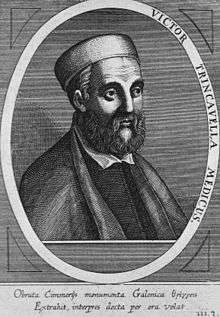Vittore Trincavelli
Vittore Trincavelli (also Vettore or Victor Trincavelli; 1496–1568) was an eminent Italian physician, but is most famous as the editor of some of the first editions of the Greek classics.
Vittore Trincavelli | |
|---|---|
 | |
| Born | 1496 |
| Died | 1588 Venice, Republic of Venice |
| Scientific career | |
| Doctoral advisor | Pietro Pomponazzi[1] |
| Notable students | Bassiano Landi Theodor Zwinger |
Biography
Trincavelli was born and died at Venice. He began his medical studies at Padua, and went afterwards to Bologna, where he became so distinguished for his knowledge of the Greek language, that the professors of the university would often consult him on difficult passages, and he was honoured by the name of the "Greek scholar." After remaining seven years at Bologna, he returned to Padua to take his doctor's degree, and then to Venice, where, his character preceding him, he was appointed successor to Sebastian Fuscareni in the chair of philosophy. His time was divided between his lectures, his private studies, and his practice as a physician. The latter was so extensive as to bring him annually about three thousand crowns of gold. In 1551 he was appointed successor to Johannes Baptista Montanus, in the medical professorship at Padua, and exchanged the profits of his practice for a salary of 950 crowns, which the senate afterwards increased to 1600. While being a professor there, he was the first who lectured on Hippocrates in the original language. Finding the infirmities of age approach, he resigned his office, and returned to Venice, where he died in 1568, aged 71.[2]
Works
His medical writings, most of which had been published separately, were printed together in 2 volumes at Leyden, in 1586 and 1592, and at Venice in 1599. He was editor of the following first editions:[2]
- Themistii Orationes, 1534.
- Joannes Grammaticus Philoponus, 1534.
- Epicteti Enchiridion, 1535.
- Hesiod, 1536. The scholia and text of this edition formed the basis of many subsequent editions.
Trincavelli also published editions of Stobaeus and other Greek writers.